The Lobster Nebula is a large emission nebula located approximately 5,900 light-years away in the constellation Scorpius. The nebula hosts several massive young star clusters and is one of the most prominent star-forming regions in the southern sky. The diffuse nebula is also known as the War and Peace Nebula. It has the designation NGC 6357 in the New General Catalogue.
NGC 6357 hosts an intricate mosaic of dark dust, gas, and protostars still embedded in their birth disks of gas. The newborn stars are invisible in optical wavelengths but show up as bright dots in the infrared band.
The nebula contains many unusually massive stars whose interstellar winds, powerful magnetic fields, gravity, and radiation pressures are carving complex structures in the surrounding dust and gas. The hot, luminous O-type stars are the main ionizing source in the area.
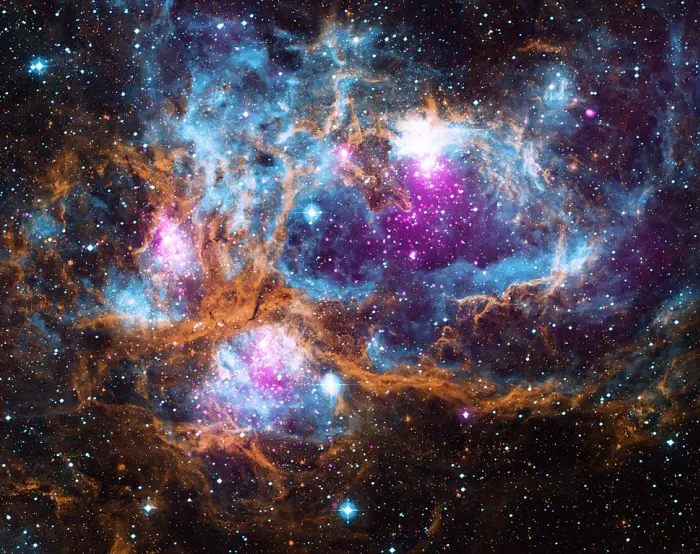
This composite image contains X-ray data from NASA’s Chandra X-ray Observatory and the ROSAT telescope (purple), infrared data from NASA’s Spitzer Space Telescope (orange), and optical data from the SuperCosmos Sky Survey (blue) made by the United Kingdom Infrared Telescope. Located in our galaxy, NGC 6357 is actually a “cluster of clusters,” containing at least three clusters of young stars, including many hot, massive, luminous stars. The X-rays from Chandra and ROSAT reveal hundreds of point sources, which are the young stars in NGC 6357, as well as diffuse X-ray emission from hot gas. There are bubbles, or cavities, that have been created by radiation and material blowing away from the surfaces of massive stars, plus supernova events. Astronomers call NGC 6357 and other objects like it “HII” (pronounced “H-two”) regions. An HII region is created when the radiation from hot, young stars strips away the electrons from neutral hydrogen atoms in the surrounding gas to form clouds of ionized hydrogen, which is denoted scientifically as “HII”.
Researchers use Chandra to study NGC 6357 and similar objects because young stars are bright in X-rays. Also, X-rays can pierce through the shrouds of gas and dust surrounding these infant stars, allowing astronomers to see details of star birth that would be otherwise missed. Image credit: NASA
The Lobster Nebula is associated with several young open clusters. These clusters – Pismis 24, G353.2+0.7, and G353.1+0.6 – host many massive O- and B-type stars, including some of the more massive stars known. Pismis 24, the nebula’s central open cluster, contains at least 20 members with more than 10 times the Sun’s mass.
The open cluster G353.2+0.7 appears east of Pismis 24 and G353.1+0.6 lies to the southeast. Each cluster contains around 800 stars, which were detected in X-ray wavelengths by NASA’s Chandra X-ray Observatory.
Pismis 24
Pismis 24, the most prominent open cluster in the Lobster Nebula, is a tenth magnitude cluster that contains several exceptionally massive young stars.
Pismis 24-1 (HD 319718), one of the brightest members of the cluster, was once believed to be the most massive star known, with an estimated mass of 300 solar masses. However, the behemoth was later discovered to be a multiple star system composed of at least three stars. The components are each among the most massive and most luminous stars known.
Pismis 24-1 was catalogued as HD 319718 and later resolved into two visual components, the spectroscopic binary Pismis 24-1 and the fainter Pismis 24-16. The primary component was classified as a hot blue supergiant of the spectral type O3.5 while the more distant companion was given the spectral type O4 III(f+), indicating a hot blue giant star. The two components are separated by around 500 astronomical units (AU).
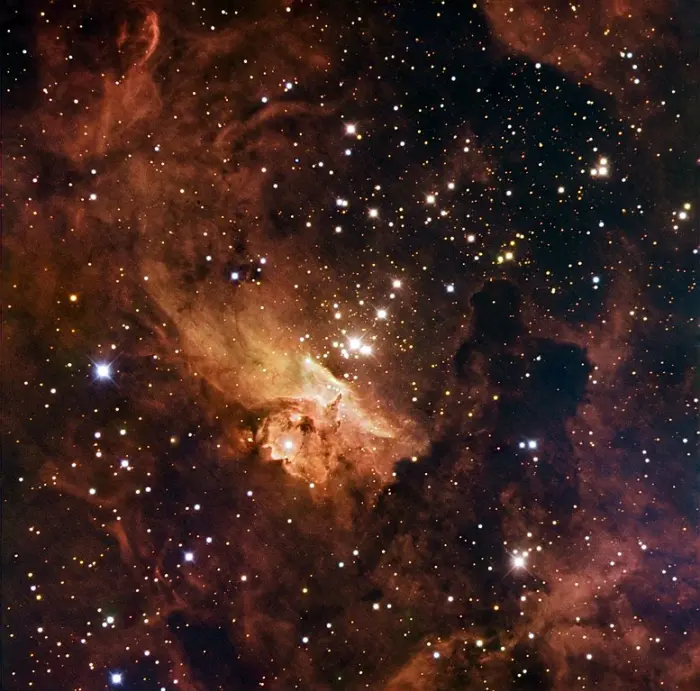
Home to some of the largest stars ever discovered, the open stellar cluster Pismis 24 blazes from the core of NGC 6357, a nebula in the constellation of Scorpius (the Scorpion). Several stars in the clusters weigh in at over 100 times the mass of the Sun, making them real monster stars. The strange shapes taken by the clouds are a result of the huge amount of blazing radiation emitted by these massive, hot stars. The gas and dust of the nebula hide huge baby stars in the nebula from telescopes observing in visible light, as well as adding to the hazy appearance of the image. Image credit: ESO/IDA/Danish 1.5 m/ R. Gendler, U.G. Jørgensen, J. Skottfelt, K. Harpsøe (CC BY 4.0)
Pismis 24-1 is classified as an eclipsing binary star, a system in which the two components eclipse each other during their orbit. The stars have an orbital period of 2.4 days. They have masses 74 and 66 times that of the Sun and surface temperatures of 42,500/41,500 K and 40,000 K. They are usually labelled as Pismis 24-1NE and Pismis 24-1SW based on their orientation with each other.
The northeastern (NE) component has a luminosity 776,000 times that of the Sun and the southwestern (SW) component shines with 646,000 solar luminosities. The stars have radii of 18 and 17 solar radii.
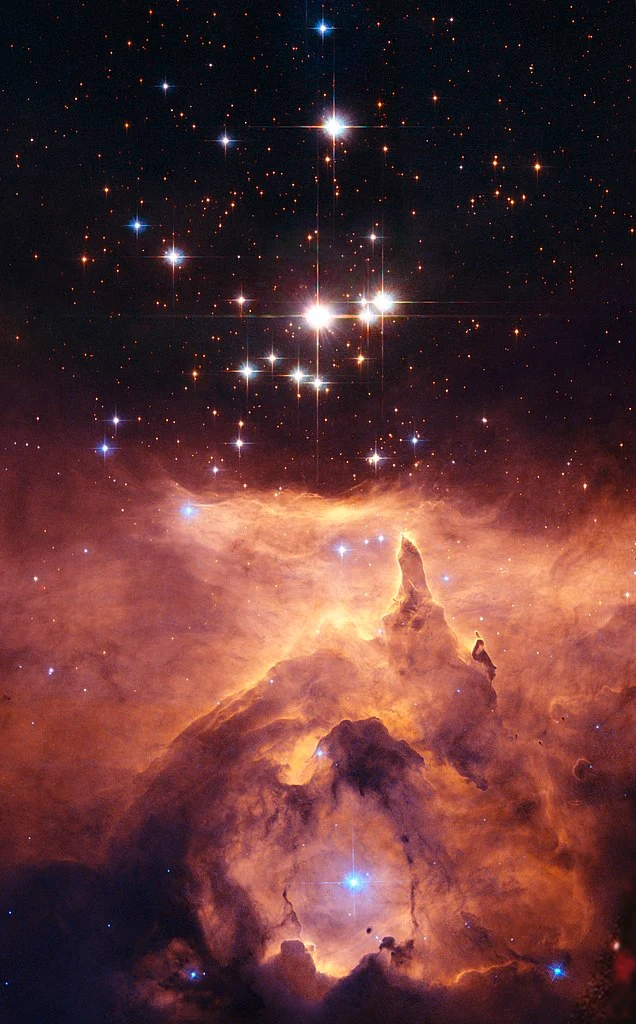
The star cluster Pismis 24 lies in the core of the large emission nebula NGC 6357 that extends one degree on the sky in the direction of the Scorpius constellation. Part of the nebula is ionised by the youngest (bluest) heavy stars in Pismis 24. The intense ultraviolet radiation from the blazing stars heats the gas surrounding the cluster and creates a bubble in NGC 6357. The presence of these surrounding gas clouds makes probing into the region even harder. Image credit: NASA, ESA and Jesús Maíz Apellániz (Instituto de Astrofísica de Andalucía, Spain). Acknowledgement: Davide De Martin (ESA/Hubble)
Other massive stars in Pismis 24 include the Wolf-Rayet star WR 93 (HD 157504) with a mass of 120 solar masses, the O-type giants Pismis 24-17 (78 M☉) and Pismis 24-13 (35 M☉), and the O-type main sequence stars Pismis 24-2 (43 M☉) and Pismis 24-3 (25 M☉).
With 120 times the Sun’s mass, WR 93 is one of the most massive stars known in the Milky Way. However, it does not come close to the current overall record holders, the Wolf-Rayet stars BAT99-98 and R136a1, and the blue supergiant Melnick 42. These stars lie in the Tarantula Nebula in the Milky Way’s close neighbour, the Large Magellanic Cloud. They have masses of 226 M☉, 196 M☉, and 189 M☉ respectively.
Facts
The name War and Peace Nebula was given to NGC 6357 by the Midcourse Space Experiment (MSX) scientists based on its appearance in infrared wavelengths. In infrared, the western portion of the nebula has a shape reminiscent of that of a dove, while the eastern portion resembles a skull.
Fans of the Japanese anime series Madoka Magica petitioned to name NGC 6357 the Madokami Nebula in 2012. Despite the nebula’s similarity to the Japanese comic character, the name has never gained wide acceptance.
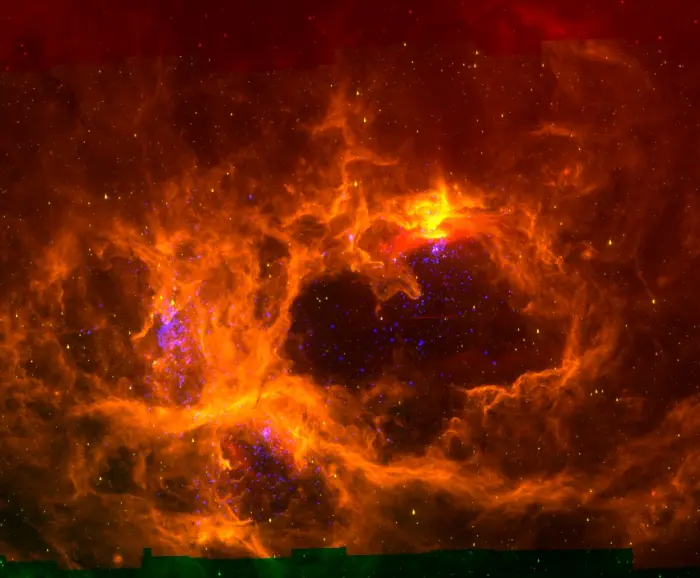
The Lobster Nebula captured by Spitzer and Chandra in X-ray and infrared wavelengths, image credit: NASA/CXO/Spitzer
The open cluster Pismis 24 was discovered in 1959. It was named after Armenian-Mexican astronomer Paris Pişmiş, who reported the discovery in Boletín de los Observatorios de Tonantzintla y Tacubaya. Pismis 24 was one of the southern star clusters that Pişmiş found on the existing Schmidt plates of the Tonantzintla Observatory in Mexico. In 1973, the cluster was resolved into 15 stars, of which 12 were cluster members.
In 2022, the Lobster Nebula was imaged by the Dark Energy Camera (DECam) mounted on the Víctor M. Blanco 4-meter Telescope at NOIRLab’s (National Optical-Infrared Astronomy Research Laboratory) Cerro Tololo Inter-American Observatory in Chile. The image was released to commemorate the Dark Energy Camera’s first decade of exploration. Using DECam, astronomers catalogued almost 1 billion objects as part of the Dark Energy Survey and the images provided them with new insights into the fundamental properties of the universe, including the complex chemistry and physics of distant objects.
The high-resolution image of the Lobster Nebula taken by the 580-megapixel wide-field CCD imager revealed the new stars embedded in their parent clouds of dust and gas, including the protostars surrounding the open cluster Pismis 24 at the center of the nebula. The image even showed the dense cores of gas that have yet to contract into stars.
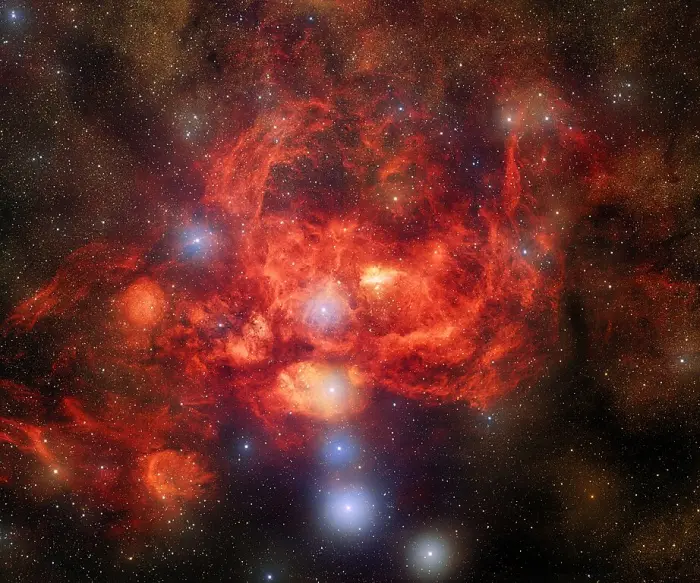
This image, taken by astronomers using the US Department of Energy-fabricated Dark Energy Camera on the Víctor M. Blanco 4-meter Telescope at Cerro Tololo Inter-American Observatory, a Program of NSF’s NOIRLab, captures the star-forming nebula NGC 6357, which is located 8000 light-years away in the direction of the constellation Scorpius. This image reveals bright, young stars surrounded by billowing clouds of dust and gas inside NGC 6357, which is also known as the Lobster Nebula. Image credit: CTIO/NOIRLab/DOE/NSF/AURA, T.A. Rector (University of Alaska Anchorage/NSF’s NOIRLab), J. Miller (Gemini Observatory/NSF’s NOIRLab), M. Zamani & D. de Martin (NSF’s NOIRLab) (CC BY 4.0)
Location
The Lobster Nebula appears in the region of the Scorpion’s stinger, marked by the stars Shaula and Lesath. The nebula can be found using the stars of the Fish Hook, an asterism that outlines the body and tail of the Scorpion, and the stars that form the Scorpion’s claws. It lies at the intersection of the imaginary lines extended from Sargas through Lesath and Dschubba through Paikauhale. Dschubba is the middle star of the Scorpion’s claws and Paikauhale is one of the two relatively bright stars flanking the supergiant Antares.
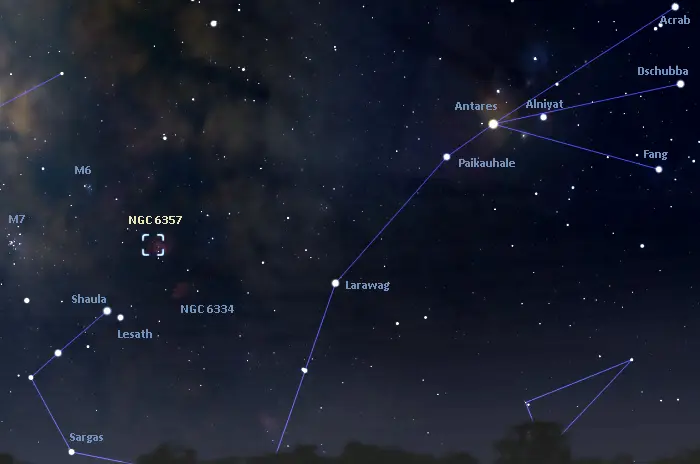
The location of the Lobster Nebula (NGC 6357), image: Stellarium
The Lobster Nebula appears in the same wide field as the Cat’s Paw Nebula (NGC 6334), another large emission nebula in Scorpius. The Cat’s Paw is a little closer to us at a distance of 4,700 light-years. The two nebulae lie in the same area as the bright open clusters Messier 6 (the Butterfly Cluster) and Messier 7 (Ptolemy’s Cluster).
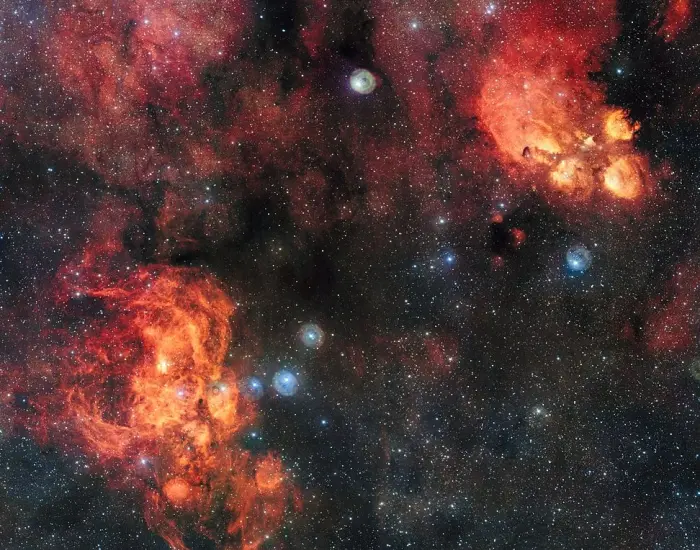
This spectacular image from the VLT Survey Telescope shows the Cat’s Paw Nebula (NGC 6334, upper right) and the Lobster Nebula (NGC 6357, lower left). These dramatic objects are regions of active star formation where the hot young stars are causing the surrounding hydrogen gas to glow red. The very rich field of view also includes dark clouds of dust. With around two billion pixels this is one of the largest images ever released by ESO. A zoomable version of this giant image is available here. Note that the circular features in the image around bright stars are not real, they are due to reflections within the optics of the telescope and camera. Image credit: ESO (CC BY 4.0)
The best time of the year to see the Lobster Nebula and other deep sky objects in Scorpius is during the month of July, when the constellation rises higher above the horizon in the evening. At declination -34°, the nebula is visible from locations south of the latitude 56° N. It appears close to the southern horizon for observers in the mid-northern latitudes.
Lobster Nebula – NGC 6357
| Constellation | Scorpius |
| Right ascension | 17h 24m 44.4s |
| Declination | −34° 12′ 11′′ |
| Apparent size | 6.2′ x 6.2′ (optical) |
| Distance | ~5,900 ± 450 light-years (1,800 ± 140 parsecs) |
| Names and designations | Lobster Nebula, War and Peace Nebula, Madokami Nebula, NGC 6357, RCW 131, Sharpless 2-11 (Sh2-11), Gum 66, Kes 53, W 22, MWSC 2588, LMH 2, MHR 65, MM 3, CTB 40 |
Images
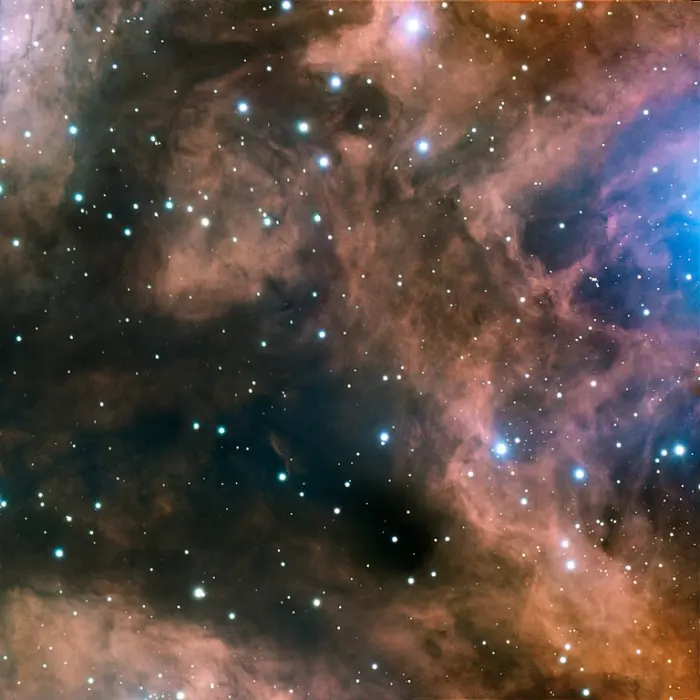
This image, captured by ESO’s Very Large Telescope (VLT) at Paranal, shows a small part of the well-known emission nebula, NGC 6357, located in the tail of the southern constellation of Scorpius (the Scorpion). The image glows with the characteristic red of an H II region, and contains a large amount of ionised and excited hydrogen gas. The cloud is bathed in intense ultraviolet radiation — mainly from the open star cluster Pismis 24, home to some massive, young, blue stars — which it re-emits as visible light, in this distinctive red hue.
The cluster itself is out of the field of view of this picture, its diffuse light seen illuminating the cloud on the centre-right of the image. We are looking at a close-up of the surrounding nebula, showing a mesh of gas, dark dust, and newly born and still forming stars. Image credit: ESO (CC BY 4.0)
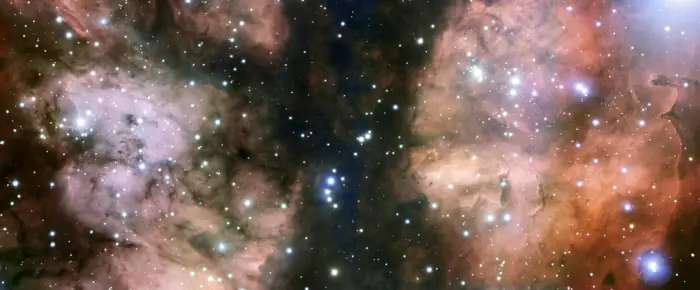
ESO’s Very Large Telescope (VLT) has taken the most detailed image so far of a spectacular part of the stellar nursery called NGC 6357. The view shows many hot young stars, glowing clouds of gas and weird dust formations sculpted by ultraviolet radiation and stellar winds. Image credit: ESO (CC BY 4.0)
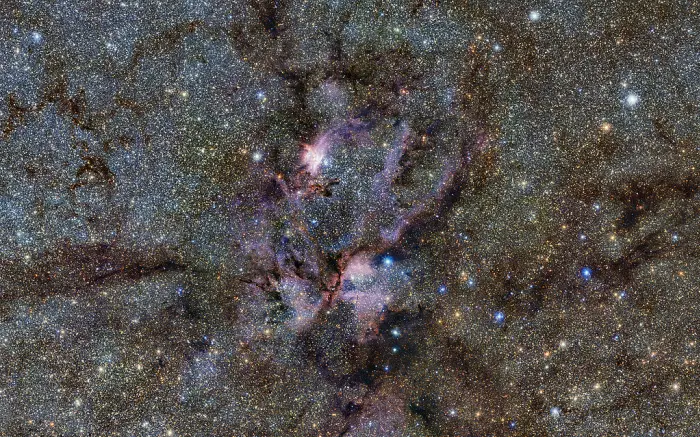
This image from ESO’s VISTA telescope captures a celestial landscape of vast, glowing clouds of gas and tendrils of dust surrounding hot young stars. This infrared view reveals the stellar nursery known as NGC 6357 in a new light. It was taken as part of the VISTA Variables in the Vía Láctea (VVV) survey, which is currently scanning the Milky Way in a bid to map our galaxy’s structure and explain how it formed. Image credit: ESO/VVV Survey/D. Minniti (CC BY 4.0)
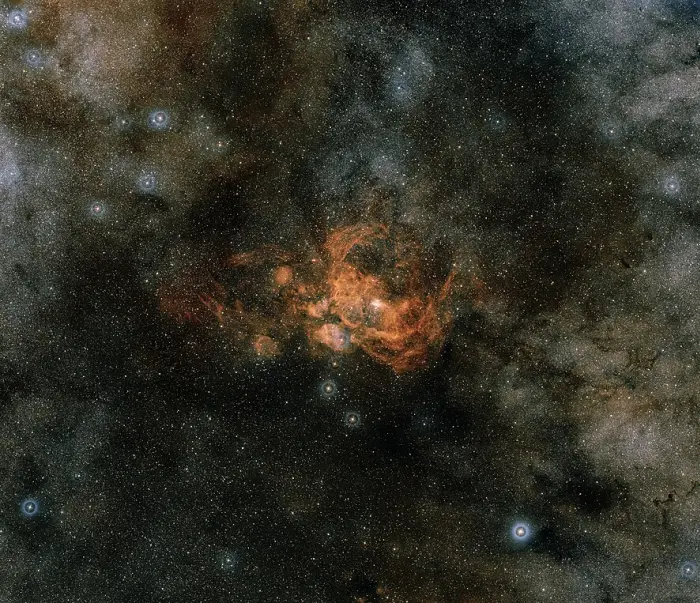
Part of the Scorpius constellation centred on NGC 6357 which has star cluster Pismis 24 in its centre. This image is a colour composite taken by the Digitized Sky Survey (DSS), the field of view is 3.8×3.3 degrees. Image: Davide De Martin (ESA/Hubble), the ESA/ESO/NASA Photoshop FITS Liberator & Digitized Sky Survey 2 (CC BY 4.0)